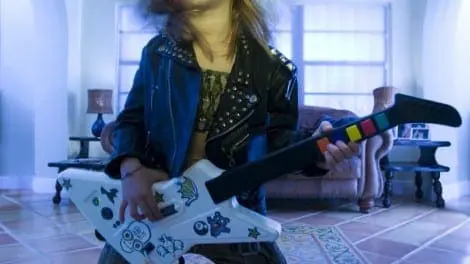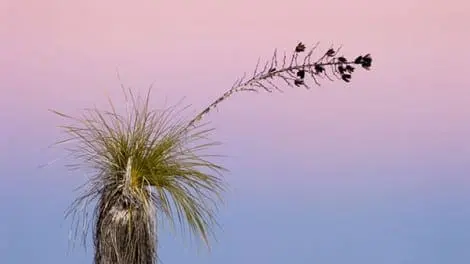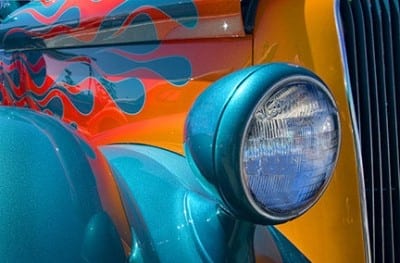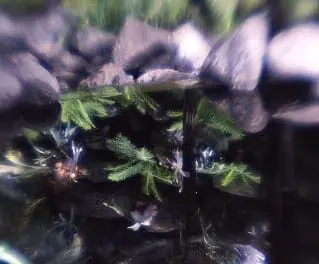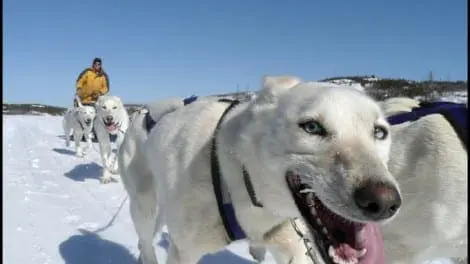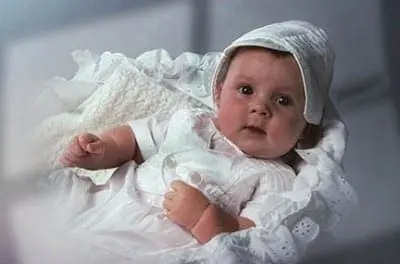DPA Magazine
Izzi Blu – A Study in Color Shifts
1. Using the camera′s color temperature for tungsten, the ambient daylight becomes blue in hue. This effect can be achieved with an on-camera flash by placing a tungsten gel on the flash head and changing your camera′s color temperature to tungsten or 3200 Kelvin. 2. Using a light balanced to tungsten gives the face a more natural color, though in this case I wanted the face to be warm and used a warmer gel to convert my key light. 3. The warmth of her face and the coolness of the environment helps to give the subject greater impact within the environment. 4. We also added a blue hair extension in her hair for style, and used neutral but warm colors in her outfit.
Feelin′ Blue – Pick a Color
Feelin′ Blue - Pick a Color by Russ Burden Color can be a very powerful graphic element in a photograph. Red, orange and yellow tones evoke a feeling of warmth while blue, green, and purple are cool and refreshing. Warm tones are often more striking and seem to pop off the page while cool ones recede and are more subdued. Color can be responsible for the mood of a photograph so depending on what you want to portray, the proper choice of color is important. The more pronounced a specific color is, the more it will impact the feel of the image. Too much color can overwhelm the viewer. It’s better to isolate a certain color or just have a single colored element in the composition to draw the viewer’s attention. This is what brings me to the premise of this article - the color challenge. Challenge yourself wherein you pick a color and concentrate on it for a day, week, month, or simply make it an ongoing theme. Every time you pick up a camera, look for subjects that portray the color. But go beyond basic capture just taking a picture with color. Make sure you stick to all the photographic concepts of good photography. Lighting, composition, depth of field, shutter speed, etc. all need to be addressed to make viewers want to study the finished theme of pictures. Simply having pictures with, for instance, red items, doesn′t mean you’ve accomplished what you set out to do. Depending on the color you choose, lighting will have a big impact on the success of the photographs. Early and late sunlight enhance warm tones and give them a very saturated look. It also tends to remove some of the coldness of blues and greens. This may be the effect you desire. Experiment and shoot in all different kinds of light. Something unexpected may surprise you in a good way. Don’t overlook different sources of artificial light. Direct flash gives a hard look while a diffuser placed in front of one softens its light and wraps around what you photograph reducing the contrast. Tungsten light used with daylight film gives an orange cast. Tungsten film shot outdoors gives a blue cast. If you’re shooting digitally, play with the white balance settings in the camera or shoot in RAW and experiment with the white balance in camera raw. With regards to composition, be cognizant of how colors play against each other. Are they too close, too far away, touch an edge and bleed off the image, too much, or too little? As you compose the image, study the entire viewfinder to make sure the above pieces fit into place. In the accompanying images I played around with the color blue. No set reason as to why I chose this color. You may pick a tone as it’s your favorite or simply pick one out of a hat. It may be a great idea for your camera club to do something like this as a theme for a monthly competition. To learn more about this topic, join me on one of my Photographic Nature Tours. Visit www.russburdenphotography.com and click on the NATURE TOURS button for more information. Also, pick up a copy of my new book, Amphoto’s Complete Book of Photography. You can purchase a signed copy directly from me or visit your local book store or Amazon. Contact me at [email protected] to order your signed copy.
Eye Popping Color
The strategic use of color allows a photographer to create compelling images. Using eye popping color to draw a viewer into a photograph is one way to achieve this. It can be used as a design element, a way to grab attention, to show comparison and contrast, and even as a main subject. As a design element it’s wise to keep the composition clean and simple. Color can easily be used to grab a viewer’s attention especially when it’s bold and vibrant. When used to contrast or compare, it’s essential to be cognizant of the colors that are included. When used as a main subject, patterns, textures and abstracts come to mind. How you choose to incorporate all the above into an image dictates the outcome of the image. Scenes with contrasting color makes the viewer of a photo move back and forth from one object to the other. If the objects are connected, side by side, or right next to each other, each will compete for attention. Careful choice of what to include in the image is essential as it’s not wise to have opposing subjects compete for attention. Look for situations where one of the objects is much closer to the front of the frame as it will become the dominant element. Another good strategy is to look for elements that show a large variation in size. When a large, boldly colored object is compared to a small boldly colored object, the large one usually wins the battle for attention. So how does a photographer achieve eye popping color? One way is to shoot at the times of day when color saturation can be maximized. The magic hours of sunrise and sunset allow this to occur. At these times, the warm colors caused by pollution, dust, and particulates that hover near the horizon create a golden hue that provides richness and warmth even in the colder tones of blue, green and purple. Avoid shooting in the middle of the day as the cool tones caused by strong blue skies robs color saturation. If you have to shoot during this time, try to get in the shade or work on overcast days. The reason color is more enhanced when it’s overcast is the glare that is cast on all objects on a sunny day subdues the color. Fall foliage is proof of the above. Try using a polarizer to minimize glare if you have to shoot in sunny conditions. Photoshop CS3 and Elements include a wonderful tool called Hue/Saturation. I’m sure the majority of readers of this article are familiar with its use but for those of you who may not know of its existence, I encourage you to rush to your computer when you’re finished reading and play with it. Activate it by going to Image / Adjustments / Hue Saturation. A box appears with three sliders. The one you need to go to is Saturation. As you slide it to the right, the color saturation is quickly enhanced. I strongly urge you to use it conservatively unless you want to go through what myself, and many other photographers new to this tool went through. I had to redo most of the files I originally worked on in that I over increased the saturation because I could and, at the time, I thought it looked great. Be aware - just because you can doesn’t mean you should. To learn more about this topic, join me on one of my Photographic Nature Tours. Visit www.russburdenphotography.com and click on the NATURE TOURS button for more information. Also, pick up a copy of my new book, Amphoto’s Complete Book of Photography. You can purchase a signed copy directly from me or visit your local book store or Amazon. Contact me at [email protected] to order your signed copy.
Red Square, Moscow
While visiting Moscow, Russia, I wanted to create a photograph that said "Red Square" and noticed this dark metal sculpture at the entrance to one side of the square. To capture a photo with similar impact, here are some suggestions: 1. Wait until the sun is very low and bright on the horizon 2. Set the color temperature on camera to Auto White Balance (AWB) 3. Slight under-exposure in the camera, minus 1/2 or 1 stop 4. Increase saturation by 25% on the in-camera menu 5. Slight cropping in Photoshop, if needed
You Never Know!
My mother taught me to never leave the house without keys, money, and clean underwear. “You never know . . .” I’ll add one more essential to that list. A CAMERA. It was a chance happening photo-op during the intermission of the Merce Cunningham Dance Company′s opening night--just outside of the Minskoff Theater, NYC - January 1980. I am certainly not a ballet buff. But my former wife was, and Barbara, my sister-in-law had tickets—I didn’t have much choice. So there I was. The silver lining: Barbara leaned over and said “That’s John Lennon.” I immediately thought of the Kremlin’s frozen coffin. Barbara had a way of putting people on, so with an attitude of total disbelief and sarcasm, I turned around and said “Where?” Not recognizing the back of his head, she practically pushed me in front of him and told me to take his picture. “Gulp!” I am not a paparazzi, and probably never will be. But I said Oh! What the heck. Embarrassment goes away in time. So I got up the nerve and got off two frames, before I got polite and asked permission. He was deep in heated conversation with Robert Rauschenberg, who designed the sets for the ballet performance. Neither objected to my photography, but politely declined to pose. John went back into the theater with Yoko, and Robert Rauschenberg went back to his argument with Louise Nevelson. I went back into the theater wondering how much intensifier I would need to get a decent negative from this way under-exposed Tri-X film. As it turned out, I managed to get a good candid and serious mood shot of a person whom I consider to be the greatest and most influential musician of our time. It is a print that I’m proud to hang on the gallery wall of my home. ~ Milton Heiberg www.miltonheiberg.com
Experiment with Blur
The following images were taken during the March Digital Photo Academy advanced class. I went into the day wanting to play with minimal depth of field and a lot of blur. I never shoot flowers in the editorial assignments that come my way. However, with the weather in Minnesota the Como Park Conservatory is a great place to spend a few Winter hours. The first group of images were shot with a Lensbaby. It is basically a special lens on a flexible tube, in which you can control selective focus for your SLR camera. In order to focus you need to push it in or extend it. You can also move the in focus "sweet spot" by bending it up and down or left and right. I was using an aperture of 2.8 for minimal depth of field and playing with the Lensbaby′s bend to get a lot of blur. The camera was set to manual mode. I wanted to focus on a single pedal, anther, or stigma of a flower and get a wash of color everywhere else. The next 8 images were the result of experimentation with foreground and background blur.In the following three images I used other flowers, leaves, or feet, to frame the flowers and building I was focusing on. The blurred tones are a result of using an aperture of f/2.8 on the 14-55 lens attached to my Lumix L1. This technique helps to bring the viewers eye to the isolated subject. The last five images are and example of blur or shallow depth of field in the background. Again an aperture of f/2.8 was used on the Lumix L1.Using this shallow depth of field lets the viewer of the image see the atmosphere or environment the subject is surrounded by. Yet, the blur of the surrounding area doesn′t distract from the in focus subject. You can see the difference between isolating the subject against a black background as in the last image and including the environment displayed in the other four in this group.You can use this same technique on portraits too. Most of the assignments I get are environmental portraits for magazines. I use these same techniques to add visual impact to those images as well. It helps make your images tell a story. All Images & Text © Tony Schreck, Minneapolis DPA Instructor
Parade Snaps at Gasparilla Day in Tampa
Photographing parades can be a lot of fun and a lot of work! DPA Tampa Instructor Sam Johnston provides photo examples and tips to getting great images that portray the energy of the day. 1. Start by getting comfortable and document the happenings of the parade. 2. Look for interesting details that will help to tell the story of the event. 3. Zoom in for close-up portraits of the people involved in the event.
On the Court with Chris Livingston
"I recently took the Panasonic L-1 digital SLR to the Notre Dame Men′s basketball game against the University of South Florida in Tampa, FL. Though it wasn′t my primary camera during the game it was one of the three remote cameras I used around the court to capture images I otherwise wouldn′t have been able to get. The L-1 was mounted to a simple tabletop tripod and placed on the floor directly in front of my courtside seat. I positioned the camera in the vertical positioned and aimed it at the basket as basketball players are generally tall and jump up. The Leica zoom lens was set to 16mm (the equivalent of 32mm for 35mm D-SLR). I had an assistant stand in front of the basket so I could manually focus the lens. One of the nice things about shooting basketball compared to other sports is you know exactly where the action will eventually be. One of the best tips I tell photographers who have never shot the sport is to zoom in on the rim, focus the lens (make sure to turn off the camera′s auto focus so that it won′t refocus later), zoom out and wait for the play to head to the basket. Another tip to get good peak action in basketball is to wait until the player is about to shoot the ball to fire the shutter. Hopefully you can time it to where the ball is just leaving the shooter′s hand. I would also recommend shooting when a player misses his shot and the group huddled around the rim jump up to get the rebound. Wait until the players are at the height of their jumps to fire the shutter. This is for two reasons. First is that this is considered peak action as the person is usually stretched out trying to grab the ball. The other is that you don′t have to use as fast of a shutter speed in order to freeze the action. My images from the game were captured with the help of using powerful flashes mounted near the rafters of the arena. This allowed me to use lower ISO (Mine was set to 200 ISO) and a smaller aperture (I had the lens set at f/5.6) for more depth of field. Try to use the fastest shutter speed and widest aperture combination that your camera and lighting scenario will allow in order to freeze the action. I would try to shoot above 1/250th of a second to limit motion blur. Play around with the settings to find what works best for you."
Extreme Photography On a Dog Sled
The Boundary Waters Canoe Area Wilderness in northern Minnesota is a popular destination for outdoor enthusiasts of all kinds. In the warm months, canoes glide across picture perfect lakes. No motors are permitted here, and save for a few hiking trails the only way to navigate this massive wilderness area is by canoe. © Mike Dvorak In the winter months the canoes are put away and the mode of travel switches to snowshoes, skis or in this case dog sleds. I’ve been mushing in northern Minnesota now for almost 11 years with my friends Mark and Mary Black of Black Magic Kennels, www.blackmagickennels.com. On this trip, Mark had been contracted to bring a group of fishermen into the BWCA and in turn asked if I could man the second team. My schedule was open so I agreed. In true northern Minnesota fashion, the morning we set out was cold and the wind was out of the north at 30 plus mph. Not a friendly environment for man, beast or digital camera! Exposed skin can freeze remarkably fast and sap a camera battery in about the same amount of time. On this trip I had no room for my SLR, so I grabbed my Panasonic TZ3 and stuffed it in an interior pocket of my parka. I’ve been impressed with this little camera since the day it arrived, but I didn’t know how it would handle these extreme conditions. © Mike Dvorak The key in cold weather conditions is keeping the battery warm, with the TZ3 it was easy enough to keep the whole camera warm in an interior pocket of my parka. When an opportunity presented itself I would trade my glove for the camera, take a few shots and quickly replace the camera in the pocket. The beautiful thing about this camera is that I can use it with one hand, leaving the other in this case, to hold onto the sled. This allows me the opportunity to capture unique perspectives that would require considerable more effort with an SLR. For example, holding the camera a few inches above the snow for a low angle view of the sled and dogs as they pull us ever further into the wilderness. Another example is holding the camera just in front of another teams lead dog giving you an intimate look at an Alaskan Husky doing what it loves to do, pull. © Mike Dvorak Self portraits are also a breeze, in this case documenting a frostbit nose. The TZ3 fared better than I and was none the worse for ware when I finally returned to Minneapolis. With a little care and common sense, your digital point and shoot can follow you almost anywhere. Here are a few tips for cold weather photography with your digital camera. © Mike Dvorak TIPS 1. Keep your camera out of the elements until you’re ready to shoot. 2. Keep a spare battery in your pocket, close to your body. 3. Determine what you’re going to photograph and compose it in your head, then take out your camera and make the photo. 4. Put the wrist strap around your wrist, cold fingers are more apt to drop things. 5. When you finally bring your camera inside, leave it in its case or your jacket pocket for at least an hour. This will limit the amount of condensation by allowing the camera to warm up slowly.
Softboxes and Umbrellas
Studio lighting can range from simple to elaborate. What you purchase depends on the needs of your clients, the size of your studio, the size of your bank account, and the effects you want to create. Very pleasing results can be achieved with a basic set up of one diffused light and a reflector. Diffusion can be created via the use of a soft box, a flash bounced into an umbrella, or a flash bounced off a white ceiling or wall. Additional lights broaden the potential to illuminate a backdrop, to create separation from the background by rim lighting the subject from behind, or as an accent light. This light can come from a different angle other than the main light or snooted to funnel the light to a given location to highlight a specific detail.

